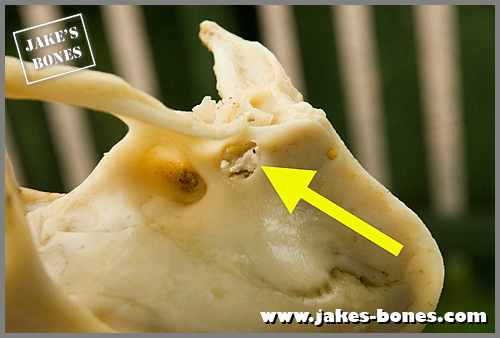- Choosing the right method of cleaning
- Cleaning bones using biological washing powder
- Cleaning bones with hydrogen peroxide
- Cleaning bones with dermestid beetles
- Cleaning bones by burial
- Leaving bones above ground to clean
- Cleaning bones in cold water (masceration)
- Cleaning bones in hot water
- Cleaning bones by boiling
- Cleaning bones with bleach
- How to dry bones after they are cleaned
- Special tip: soft tissue and fat remains
- Special tip: rotting down fish
- Special tip: mummified bodies
- Special tip: green bones and antlers
Back in 2009 I wrote a post about how to clean up animal bones. Over the last three years that has always been my most popular post on the site, but I have learned a lot since then so in October 2012 I wrote this new page, all about cleaning bones.
You don't need to clean every bone you find. If it has been out in the open, doesn't have any soft tissue on it, and doesn't smell, then it is pretty much clean. It is rare to get diseases from any kind of bone like this. the bone does smell then I use rubber gloves to handle it until it's clean.
This is my personal guide. This is what I have found out from five years of bone collecting. Other people might have different ideas but these are the ones which work for me.
There are eight good and two bad techniques to clean bones, but I have missed out one of the good ones because it was told to me as a secret. A lot depends on what state the bones are in at the start. I prefer to leave the bones until have no soft tissue left but that isn't always possible, especially if it's small animal where the bones are small and might get lost
To begin with, what condition are the bones in already ? Are they dry with no soft tissue, do they have some flesh attached, or is the animal recently dead ? Choose from the top row, then look down the column to see which are good ways to clean the bones. There is more about each method below.
Choosing the right method of cleaning
What the symbols mean:
 | This means this is a good way of cleaning the bones |
 | This means it might work, but it might not, or that it might work but it is messy or smelly |
 | This means I do not recommend doing this at all. |
Cleaning bones using biological washing powder
Biological washing powder can be bought from supermarkets and is the type of powder used for cleaning clothes in a washing machine. It is very cheap. Some people recommend Biotex but I have never used it.
Biological washing powder contains enzymes are tiny, tiny organisms which break down fat and soft tissue. You add the powder to hot or warm water (not boiling water, see below) and leave bones in for usually a few days. It helps if the water is kept warm in this time. After you finish, rinse the bones really well other wise the enzymes will keep eating the bone. Then dry them using the method below.
This method is the one recommended to me by museums. It's cheap and easy to do, as long as there is only a very small amount of soft tissue left, or none at all.
UPDATE, NOVEMBER 2012: I now use the Super Superb Skull and Skeleton Sterilising System I invented but some people use a slow cooker.
Cleaning bones with hydrogen peroxide
Hydrogen peroxide is a chemical which bleaches the bone without damaging it. It can be difficult to get hold of in large quantities. For even a small skull, you might need one or two litres. Chemists sell it in very small bottles, but I buy it from hairdresser supply stores. It is difficult to buy large quantities because you can make bombs from it. I can't buy the highest concentration now (12%) but I can still buy 9% and 6%. Hydrogen peroxide at 12% is also known as "40-strength". It costs about £4 a litre.The liquid version is much better than the creme version, because the creme version will foam up after a while and overflow.
When you take out the bones, rinse them well in a bucket of cold water otherwise you will get white powder residue on the bones. You can reuse the peroxide a few times. It seems to be reused better when it hasn't been exposed to much air. If it's warmer, the peroxide will work better.
Peroxide will not dissolve soft tissue or flesh but it can soften the tissue to make it easier to remove. It also sterilises the bone.
Cleaning bones with dermestid beetles
Dermestid beetles are beetles that eat dead flesh. They are kept in special tanks, and kept warm and constantly fed with dead things. They are tiny, smaller than a fingernail, but they can eat a lot of flesh in a small time leaving the bone nice and clean.
Cleaning bones by burial
Burying a dead body might seem obvious but it is not as good as leaving the bones above ground. If you need to bury, leave the body above ground for a day or so in warm weather so flies can lay eggs which make maggots which eat the flesh.
I buried this fox, my squirrel and a fallow deer head. The difficult part is knowing when to dig up. The fallow deer head wasn't properly done and still needed lots and lots of cleaning afterwards. It would have been better to leave it for a another couple of months.
I wrapped the fox in the wire mesh to keep the bones together and to stop other animals if they dug it up (they didn't). For small animals you can wrap in a muslin bag , which is a thin material.
If you bury in the wrong type of soil, like sand or very wet soil, it can actually preserve the body !
Leaving bones above ground to clean
I left my roadkill badger Emily wrapped in mesh hidden in a wood. I left it for eight months and it still wasn't fully decomposed, but I needed to move it quickly. After I did, I simmered the bones in water with biological washing powder.
Cleaning bones in cold water (masceration)
I have used soaking in cold water for when the body is skeletonised but there are still tendons attached like in the picture above. The water softens the tendons and makes them easier to cut.
Cleaning bones in hot water
When someone shoots a stag with a gamekeeper there, the gamekeeper will usually offer to mount the skull as a present. To do it quickly (usually the next day) he will cut off the fur skin and most of the flesh, and simmer (not boil) it in a big pot until the flesh falls off.WARNING: If you do this in a Le Creuset pan your mother WILL shout at you and you WILL get grounded for forever.
This is generally not the best way for most people. It is messy and smelly, but it is quick.Adding biological washing powder can help too.
UPDATE, NOVEMBER 2012: I now use the Super Superb Skull and Skeleton Sterilising System I invented but some people use a slow cooker.
UPDATE, DECEMBER 2013: This is now the method I use the most. I use a slow cooker, and add biological washing powder. I normally leave it overnight on "High" when my mum is away, because the small of the biological washing powder is not good.
WARNING: I have had one juvenile red deer skull which fell apart into dust after being simmered for a second time. I'm not sure what I did wrong, whether it was too long (it was 13 hours), too much biological washing powder, whether the water was too hot, or whether I added cold water too quickly. I recommend only going this for about six hours, on medium, and let it cool down slowly afterwards.
PRO TIP: If your mother doesn't know you use her slow cooker for cleaning bones, try to not mention it on live, prime-time television.
Cleaning bones by boiling
NEVER PUT BONES IN BOILING WATER. This makes any fat present thinner, so it can soak inside the actual bone, and it will lock the fat inside the bone when it cools. The fat will come to the surface over time and make your bones look rubbish and horrible.If you have boiled bones already, try using biological washing powder to get rid of the fat.
Cleaning bones with bleach
DO NOT CLEAN BONES WITH BLEACH. It damages the surface of the bone. Use hydrogen peroxide instead.How to dry bones after they are cleaned
If there is any dirt left, I use a toothbrush to take it off. It should come off easily.
Wet bones often look dirty but don't panic ! Look how these badger bones came out the water brown, but they dried grey ! Nothing was done to them between these two pictures, they just dried:
Special tip: soft tissue and fat remains
Sometimes you end up with tiny amounts of soft tissue left after cleaning the bone. You can tell by the horrible smell. This is bad and fiddly to solve
You can try and remove it with tweezers,wire or high pressure water from a hosepipe. Bugs usually won't eat it once it's been through peroxide or biological washing powder, but you can leave it out to dry and drop off.
In this fallow deer jaw, there was soft tissue that was hard to reach in the root canal. I pushed down a cable tie and used it to 'floss' the dead flesh out. Then I used high pressure water from a hosepipe to push the bits out.
Special tip: rotting down fish
Don't. Just don't.
If you must, try cooking them instead.

































